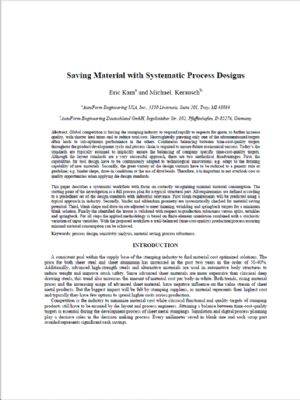 Tooling
ToolingSaving Material with Systematic Process Designs
 LOG IN TO DOWNLOAD WHITE PAPER
LOG IN TO DOWNLOAD WHITE PAPER
Abstract. Global competition is forcing the stamping industry to respond rapidly to requests for quote, to further increase quality, with shorter lead times and to reduce total cost. Shortsightedly pursuing only one of the aforementioned targets often leads to sub-optimum performance in the others. Continuous balancing between time-cost-quality targets throughout the product development cycle and process chain is required to ensure future economical success. Today’s die standards are typically assumed to implicitly ensure the balancing of company specific time-cost-quality targets. Although die layout standards are a very successful approach, there are two methodical disadvantages. First, the capabilities for tool design have to be continuously adapted to technological innovations; e.g. adapt to the forming capability of new materials. Secondly, the great variety of die design variants have to be reduced to a generic rule or guideline; e.g. binder shape, draw-in conditions or the use of drawbeads. Therefore, it is important to not overlook cost or quality opportunities when applying die design standards.
This paper describes a systematic workflow with focus on correctly recognizing minimal material consumption. The starting point of the investigation is a full process plan for a typical structural part. All requirements are defined according to a predefined set of die design standards with industrial relevance. First blank requirements will be predicted using a typical approach in industry. Secondly, binder and addendum geometry are systematically checked for material saving potential. Third, blank shape and draw-in are adjusted to meet thinning, wrinkling and springback targets for a minimum blank solution. Finally the identified die layout is validated with respect to production robustness versus splits, wrinkles and springback. For all steps the applied methodology is based on finite element simulation combined with a stochastic variation of input variables. With the proposed workflow a well-balanced (time-cost-quality) production process assuring minimal material consumption can be achieved.
Autoform Engineering USA





Comments
Must be logged in to post a comment. Sign in or Create an Account
There are no comments posted.